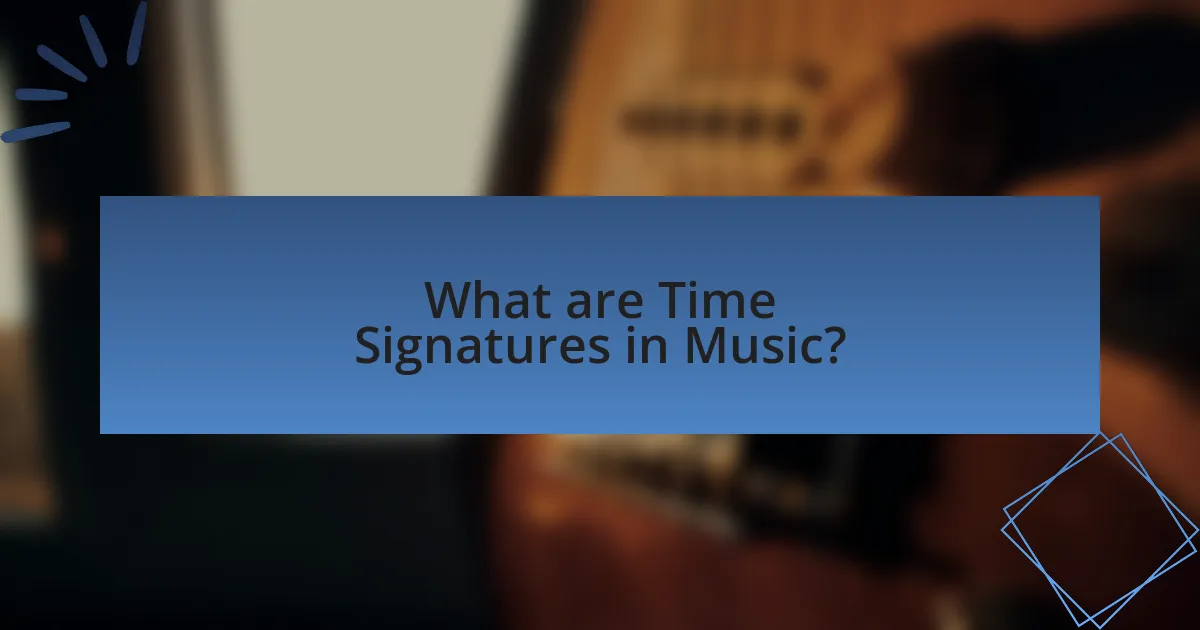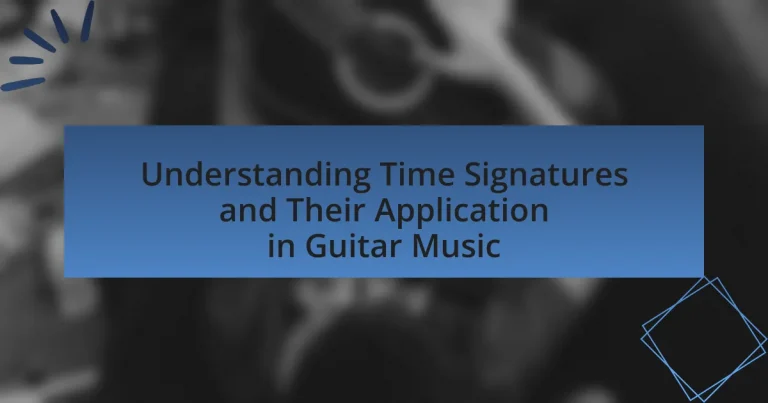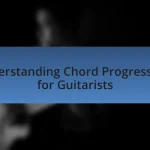Time signatures are essential notations in music that indicate the number of beats in each measure and the note value that represents one beat. This article explores the significance of time signatures in defining musical rhythm, their components, and their influence on the feel of a piece. It discusses common time signatures used in guitar music, such as 4/4, 3/4, and 6/8, and how they affect performance techniques, including strumming patterns and fingerpicking styles. Additionally, the article highlights the importance of understanding time signatures for improving musicality, improvisation, and songwriting skills among guitarists.

What are Time Signatures in Music?
Time signatures in music are notations that indicate the number of beats in each measure and the note value that represents one beat. They are typically expressed as a fraction, with the top number showing how many beats are in a measure and the bottom number indicating the note value that receives one beat, such as 4 for a quarter note or 8 for an eighth note. For example, a 4/4 time signature means there are four beats per measure, and the quarter note gets one beat. This system helps musicians understand the rhythmic structure of a piece, facilitating accurate performance and composition.
How do time signatures define musical rhythm?
Time signatures define musical rhythm by indicating how many beats are in each measure and what note value is considered one beat. For example, a 4/4 time signature means there are four beats per measure, with the quarter note receiving one beat. This structure establishes the rhythmic framework for a piece of music, guiding the placement of notes and rests, which in turn influences the overall feel and flow of the composition. The consistency of the time signature allows musicians to synchronize their playing, ensuring cohesion in ensemble performances.
What are the different components of a time signature?
A time signature consists of two main components: the top number and the bottom number. The top number indicates how many beats are in each measure, while the bottom number specifies the note value that represents one beat. For example, in a 4/4 time signature, the “4” on top signifies four beats per measure, and the “4” on the bottom indicates that a quarter note receives one beat. This structure is essential for understanding rhythm and meter in music, particularly in guitar music, where timing plays a crucial role in performance and composition.
How do time signatures influence the feel of a piece?
Time signatures significantly influence the feel of a piece by determining the rhythmic structure and flow of the music. For instance, a 4/4 time signature creates a steady, driving feel commonly found in rock and pop music, while a 3/4 time signature evokes a waltz-like, flowing quality, often associated with classical and folk genres. The choice of time signature affects how musicians interpret the rhythm, leading to variations in dynamics and expression. Historical examples include the use of 6/8 time in traditional Irish jigs, which imparts a lively, danceable character, contrasting with the more subdued feel of 2/4 time in marches. Thus, time signatures are essential in shaping the emotional and stylistic essence of a musical piece.
Why are time signatures important for musicians?
Time signatures are important for musicians because they dictate the rhythmic structure of a piece of music. By defining how many beats are in each measure and what note value constitutes one beat, time signatures provide a framework for timing and coordination among musicians. For example, a 4/4 time signature indicates four beats per measure, with the quarter note receiving one beat, which is the most common time signature in Western music. This clarity allows musicians to interpret and perform music consistently, ensuring that they stay in sync with one another and maintain the intended feel of the piece.
How do time signatures affect performance and interpretation?
Time signatures significantly influence performance and interpretation by dictating the rhythmic structure and feel of a piece. For instance, a 4/4 time signature creates a steady, even pulse that is commonly associated with popular music, allowing performers to maintain a consistent tempo and facilitating audience engagement. In contrast, a 3/4 time signature introduces a waltz-like feel, prompting performers to emphasize the first beat of each measure, which alters the emotional delivery and interpretative choices. Historical examples, such as the use of 6/8 in folk music, demonstrate how time signatures can evoke specific cultural contexts and moods, guiding musicians in their expressive decisions. Thus, the choice of time signature not only shapes the technical execution but also profoundly affects the interpretative nuances of a performance.
What role do time signatures play in composition?
Time signatures play a crucial role in composition by defining the rhythmic structure and feel of a piece of music. They indicate how many beats are in each measure and what note value is considered one beat, which directly influences the tempo and phrasing of the music. For example, a 4/4 time signature suggests a strong, steady pulse that is common in many genres, while a 3/4 time signature creates a waltz-like feel, emphasizing different beats. This rhythmic framework guides composers in creating patterns and variations, allowing for expressive dynamics and emotional impact in their compositions.

What are the Common Time Signatures Used in Guitar Music?
The common time signatures used in guitar music include 4/4, 3/4, and 6/8. The 4/4 time signature, also known as common time, is the most prevalent in various genres, providing a steady rhythm suitable for rock, pop, and classical music. The 3/4 time signature, often associated with waltzes, features three beats per measure, creating a distinct, flowing feel. The 6/8 time signature, which has six eighth notes per measure, is frequently used in folk and some rock music, offering a compound rhythm that adds a lively character to the piece. These time signatures are foundational in guitar music, influencing the style and feel of compositions.
What are the most frequently used time signatures in guitar music?
The most frequently used time signatures in guitar music are 4/4, 3/4, and 6/8. The 4/4 time signature, also known as common time, is prevalent in various genres, including rock, pop, and blues, providing a steady and familiar rhythmic foundation. The 3/4 time signature, often associated with waltzes, creates a flowing, dance-like feel, while the 6/8 time signature offers a compound rhythm that is commonly found in folk and traditional music. These time signatures are widely recognized and utilized by guitarists across different styles, reinforcing their significance in guitar music.
How does 4/4 time signature differ from 3/4 and 6/8?
The 4/4 time signature differs from 3/4 and 6/8 in its beat structure and rhythmic feel. In 4/4, there are four beats per measure, with each quarter note receiving one beat, creating a strong, steady pulse commonly used in various music genres. In contrast, 3/4 has three beats per measure, emphasizing a waltz-like feel, where the first beat is typically stronger. Meanwhile, 6/8 features six eighth notes per measure, grouped into two sets of three, resulting in a compound meter that gives a lilting, flowing rhythm. These differences in beat count and grouping affect how music is composed and performed, influencing the overall feel and style of the piece.
What are examples of songs in various time signatures?
Examples of songs in various time signatures include “Take Five” by Dave Brubeck in 5/4, “Money” by Pink Floyd in 7/4, and “Kashmir” by Led Zeppelin in 4/4. “Take Five” is notable for its unique 5/4 time, which creates a distinct rhythmic feel, while “Money” uses 7/4 to enhance its progressive rock sound. “Kashmir” employs a 4/4 time signature but features a complex arrangement that gives it a unique character. These songs illustrate how different time signatures can influence the overall feel and complexity of music.
How can guitarists identify and use different time signatures?
Guitarists can identify and use different time signatures by recognizing the number of beats in each measure and the type of note that receives one beat. For example, a 4/4 time signature indicates four beats per measure, with the quarter note receiving one beat, while a 3/4 time signature has three beats per measure, with the quarter note also receiving one beat. Guitarists can practice by counting aloud or tapping their foot to internalize the rhythm associated with each time signature. Additionally, they can analyze sheet music or tablature to see how different time signatures are notated and applied in various pieces, enhancing their ability to play in those signatures accurately. Understanding the context of time signatures in genres, such as 6/8 in folk music or 5/4 in progressive rock, further aids guitarists in their application.
What techniques can help in recognizing time signatures while playing?
To recognize time signatures while playing, musicians can employ techniques such as counting beats aloud, tapping rhythms, and using visual aids like time signature charts. Counting beats aloud helps internalize the rhythm and reinforces the structure of the time signature, while tapping rhythms on a surface allows for a physical connection to the timing. Visual aids provide a quick reference that can enhance understanding and retention of different time signatures. These methods are effective because they engage multiple senses, facilitating better recognition and recall of rhythmic patterns in music.
How can guitarists practice playing in different time signatures?
Guitarists can practice playing in different time signatures by using a metronome set to various beats per measure, such as 4/4, 3/4, and 6/8. This method allows them to internalize the feel of each time signature while playing scales, chords, or specific songs that exemplify those signatures. Additionally, guitarists can incorporate rhythmic exercises that emphasize the strong and weak beats characteristic of each time signature, enhancing their rhythmic accuracy and versatility. For instance, practicing with backing tracks that feature different time signatures can further solidify their understanding and application in real musical contexts.

How do Time Signatures Affect Guitar Playing Techniques?
Time signatures significantly influence guitar playing techniques by dictating the rhythmic structure and phrasing of music. For instance, a 4/4 time signature encourages a steady strumming pattern, allowing guitarists to emphasize downbeats, while a 3/4 time signature promotes a waltz feel, leading to different picking and strumming techniques that accentuate the first beat of each measure. Additionally, complex time signatures like 7/8 or 5/4 require guitarists to adapt their techniques to maintain the flow and coherence of the rhythm, often incorporating syncopation or varied picking patterns to align with the unique subdivisions of the beats. This adaptability is essential for executing styles such as progressive rock or jazz, where unconventional time signatures are prevalent.
What playing techniques are influenced by time signatures?
Time signatures influence various playing techniques, including strumming patterns, rhythmic accents, and phrasing. For instance, a 4/4 time signature typically encourages steady downstrokes and upstrokes in strumming, while a 3/4 time signature may lead to a waltz-like feel, prompting a different approach to accents and dynamics. Additionally, complex time signatures like 7/8 can inspire unique picking patterns and syncopation, requiring guitarists to adapt their techniques to maintain the groove. These adaptations are essential for aligning with the rhythmic structure dictated by the time signature, ensuring that the music flows cohesively.
How does strumming pattern change with different time signatures?
Strumming patterns vary significantly with different time signatures, as they dictate the rhythmic structure of the music. In a 4/4 time signature, common strumming patterns include down-up strums on each beat, creating a steady rhythm. In contrast, a 3/4 time signature typically features a strong down strum on the first beat followed by lighter up strums on the second and third beats, emphasizing the waltz feel. Additionally, in a 6/8 time signature, strumming often incorporates a triplet feel, with down strums on the first and fourth beats, creating a flowing rhythm. These variations in strumming patterns align with the underlying pulse and accentuation dictated by each time signature, demonstrating how rhythm influences guitar playing.
What fingerpicking styles are suited for various time signatures?
Fingerpicking styles vary in their suitability for different time signatures, with specific techniques enhancing the rhythmic feel of each signature. For example, in 4/4 time, the Travis picking style is effective, as it emphasizes a steady bass line with alternating bass notes and melody, creating a strong rhythmic foundation. In contrast, 3/4 time benefits from the use of waltz fingerpicking, which typically involves a bass note followed by two higher strings, accentuating the triplet feel inherent in this signature. For 6/8 time, a fingerpicking style that incorporates syncopation, such as the alternating bass with melody, can create a flowing, dance-like quality that complements the compound meter. These associations between fingerpicking styles and time signatures are supported by common practices in folk, classical, and contemporary guitar music, where specific techniques are employed to enhance the overall musical expression within each time signature.
How can understanding time signatures improve musicality in guitarists?
Understanding time signatures enhances musicality in guitarists by providing a framework for rhythm and phrasing. This knowledge allows guitarists to interpret and perform music more expressively, as they can align their playing with the intended rhythmic structure of a piece. For instance, recognizing a 4/4 time signature helps guitarists maintain a steady beat, facilitating synchronization with other musicians. Additionally, familiarity with various time signatures, such as 3/4 or 6/8, enables guitarists to explore different styles and genres, enriching their overall musical versatility. Studies in music education indicate that musicians who grasp rhythmic concepts demonstrate improved timing and creativity in their performances, further validating the importance of understanding time signatures in enhancing musicality.
What are the benefits of mastering time signatures for improvisation?
Mastering time signatures for improvisation enhances rhythmic versatility and creative expression. Musicians who understand various time signatures can navigate complex rhythms, allowing them to improvise more freely and effectively across different musical styles. For instance, familiarity with 4/4, 3/4, and 6/8 time signatures enables guitarists to adapt their playing to genres like rock, waltz, and jazz, respectively. This adaptability not only broadens a musician’s repertoire but also fosters a deeper connection with the music, as they can respond to changes in tempo and feel. Additionally, studies in music cognition indicate that rhythmic training improves overall musicality, reinforcing the importance of mastering time signatures for effective improvisation.
How does knowledge of time signatures enhance songwriting skills?
Knowledge of time signatures enhances songwriting skills by providing a framework for rhythm and structure in music composition. Understanding different time signatures, such as 4/4, 3/4, and 6/8, allows songwriters to create varied rhythmic patterns and emotional dynamics, which can significantly influence the feel and flow of a song. For instance, a 4/4 time signature is commonly used in pop music for its straightforward and driving rhythm, while a 3/4 time signature can evoke a waltz-like feel, adding a lyrical quality to the composition. This knowledge enables songwriters to experiment with meter, creating unique grooves and enhancing the overall musicality of their work.
What are some practical tips for mastering time signatures on guitar?
To master time signatures on guitar, practice playing along with a metronome to develop a strong sense of timing. This method helps guitarists internalize different time signatures, such as 4/4, 3/4, and 6/8, by providing a consistent beat to follow. Additionally, breaking down complex rhythms into smaller, manageable sections allows for focused practice, making it easier to understand how each note fits within the time signature. Playing along with songs that feature various time signatures can also enhance familiarity and adaptability. For instance, many popular songs utilize 4/4 time, while others may incorporate 3/4 or 5/4, providing practical examples for application.


